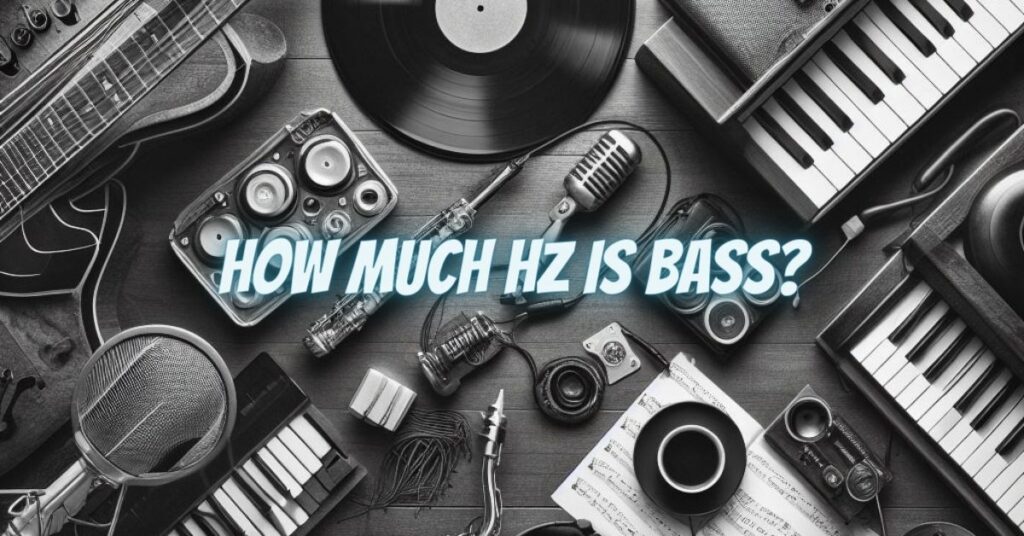The frequency range for bass is generally considered to be from 20 Hz to 250 Hz. However, the specific frequencies that are most important for bass will depend on the type of music you are playing and the sound you are trying to achieve.
For example, if you are playing heavy metal music, you may want to boost the frequencies below 100 Hz to get a very heavy, low-end sound. If you are playing funk music, you may want to boost the frequencies around 80 Hz to get a punchy, funky sound.
Here is a more detailed breakdown of the different frequency ranges for bass:
- Sub-bass (20 Hz to 60 Hz): This is the lowest frequency range for bass. It is responsible for the deep, rumbly bass sounds that are often felt more than heard. Sub-bass frequencies are often boosted in electronic music and hip hop.
- Low bass (60 Hz to 100 Hz): This frequency range is responsible for the low-end thump of a bass guitar or kick drum. It is also the frequency range that is most important for vocals. Low bass frequencies are often boosted in rock, pop, and country music.
- Mid bass (100 Hz to 250 Hz): This frequency range is responsible for the punch and clarity of a bass guitar or kick drum. It is also the frequency range that is most important for guitars and other instruments. Mid bass frequencies are often boosted in all genres of music.
It is important to note that these are just general guidelines. The best way to find the right bass frequencies for your music is to experiment and listen to what sounds good to you.
Here are a few tips for getting the most out of your bass frequencies:
- Use a good quality subwoofer. A subwoofer is specifically designed to reproduce low frequencies, so it will help to get the most out of your bass.
- Place your subwoofer in a corner of the room. This will help to amplify the bass frequencies.
- Experiment with different EQ settings. Boosting the bass frequencies in your EQ can help to make your music sound louder and more punchy. However, be careful not to overdo it, as too much bass can make your music sound muddy.
- Use reference tracks. Listen to other songs in your genre and pay attention to how the bass sounds. Try to emulate the bass sound in your own music.
With a little experimentation, you can find the perfect bass frequencies for your music.
How to find the right bass frequencies for your car
The best bass frequency for a car depends on a number of factors, including the type of car, the size and type of speakers, and the personal preferences of the listener. However, in general, the best bass frequency for most cars is between 60 and 80 Hz.
This frequency range is responsible for the low-end thump of a bass guitar or kick drum, and it is also the frequency range that is most important for vocals. Boosting the bass frequencies in this range can help to make your music sound louder and more punchy.
However, it is important to note that too much bass can make your music sound muddy and distorted. It is important to find a balance between bass and treble, and to experiment with different EQ settings to find what sounds best to you.
Here are a few tips for getting the most out of your car bass:
- Use a good quality subwoofer. A subwoofer is specifically designed to reproduce low frequencies, so it will help to get the most out of your bass.
- Place your subwoofer in a corner of the trunk. This will help to amplify the bass frequencies.
- Experiment with different EQ settings. Boosting the bass frequencies in your EQ can help to make your music sound louder and more punchy. However, be careful not to overdo it, as too much bass can make your music sound muddy.
- Use reference tracks. Listen to other songs in your genre and pay attention to how the bass sounds. Try to emulate the bass sound in your own music.
If you are not sure where to start, here are a few recommended bass frequencies for different types of cars:
- Small cars: 60-70 Hz
- Medium cars: 70-80 Hz
- Large cars: 80-90 Hz
You can also adjust the bass frequency based on the type of music you are listening to. For example, if you are listening to electronic music, you may want to boost the bass frequencies below 60 Hz. If you are listening to classical music, you may want to boost the bass frequencies above 80 Hz.
Ultimately, the best way to find the perfect bass frequency for your car is to experiment and listen to what sounds good to you.


